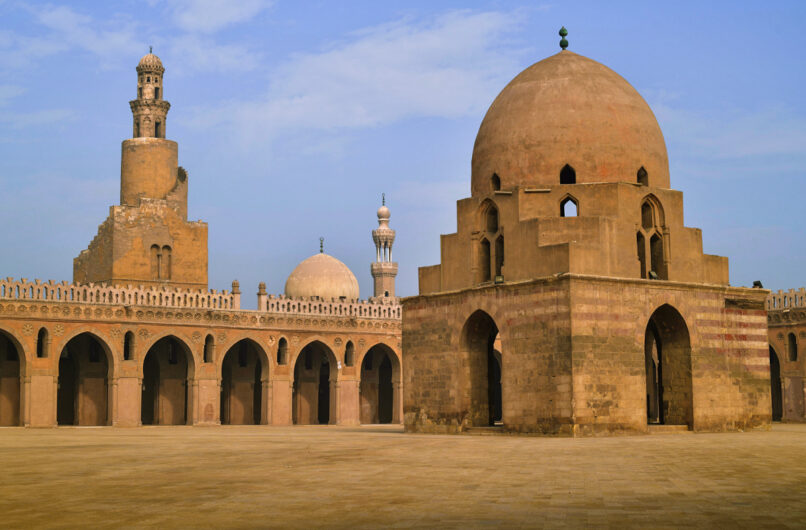
The Mosque of Ibn Tulun: A Masterpiece of Islamic Architecture
The Mosque of Ibn Tulun is an ancient Islamic mosque in Cairo, Egypt. It is one of Egypt’s oldest and most significant mosques, with stunning architecture and a rich history. This blog post will examine the Mosque of Ibn Tulun and explore its history, architecture, and cultural significance.
History of the Mosque of Ibn Tulun
The Mosque of Ibn Tulun was built during the Abbasid Caliphate, around 876 AD. It was constructed by Ahmed Ibn Tulun, the governor of Egypt at the time. The mosque was designed to symbolize the power and wealth of the Abbasid Caliphate, and it was one of the largest mosques in the world at the time of its construction.
The mosque has undergone several renovations and restorations throughout its history but has remained unchanged since its original construction.
The Mosque of Ibn Tulun holds a significant place in the history of Egypt and the Islamic world. During the reign of Ahmad Ibn Tulun, the mosque was built as part of his larger vision to establish an independent state, separate from the central Abbasid Caliphate. Ibn Tulun, who was appointed governor of Egypt in the 9th century, sought to assert his authority by commissioning grand architectural projects, with the mosque being the most notable among them. The mosque not only served as a religious center but also symbolized the growing power of the Tulunid dynasty. Over the centuries, it has witnessed several key events, including the Mamluk and Ottoman periods, which influenced the architectural landscape of Cairo. Despite facing challenges such as natural disasters and political shifts, the mosque has retained its original design and remains a masterpiece of early Islamic architecture.
The architecture of the Mosque of Ibn Tulun
The architecture of the Mosque of Ibn Tulun is a masterpiece of Islamic architecture. The mosque features a large courtyard, a prayer hall, and several smaller chambers. The square is surrounded by a colonnade of 128 columns, each decorated with intricate carvings and inscriptions.
The prayer hall is supported by six massive columns carved with intricate geometric patterns. The hall’s walls are covered with intricate tilework and plasterwork, which depict various scenes from Islamic history and culture. One of the most impressive features of the Mosque of Ibn Tulun is its minaret. The minaret stands over 26 meters tall and is one of the most towering minarets in the world. It is decorated with intricate carvings and inscriptions and provides stunning views of Cairo and the surrounding area.
Cultural Significance of the Mosque of Ibn Tulun
The Mosque of Ibn Tulun is significant for its cultural and historical importance. The mosque symbolizes the power and wealth of the Abbasid Caliphate and is a testament to the ingenuity and creativity of Islamic architecture.
The mosque is also significant for its religious importance. It is still used as a mosque today and is a popular destination for Muslims who pray and worship. The mosque is known for its peaceful and inclusive atmosphere, and it is a symbol of the tolerance and acceptance that is inherent in Islam.
Visiting the Mosque of Ibn Tulun
The Mosque of Ibn Tulun is open to visitors daily and is a popular tourist destination in Cairo. Visitors can explore the mosque’s various chambers, courtyards, and prayer halls. They can also see the intricate carvings and tilework adorn the mosque’s walls and columns.
Visitors can also learn about the history and construction of the mosque at the nearby Ibn Tulun Mosque Museum. The museum features exhibits on the mosque’s history and a collection of artifacts and Islamic calligraphy.
Conclusion
The Mosque of Ibn Tulun is a masterpiece of Islamic architecture, offering a glimpse into Islamic civilization’s rich history and culture. Its stunning design features, intricate carvings, and cultural significance make it a must-visit destination for anyone interested in history, architecture, and culture. If you plan a trip to Cairo, include the Mosque of Ibn Tulun on your itinerary. It is a unique and unforgettable experience that will leave you with a newfound appreciation for Islamic art and architecture.
- July 6, 2023
- 628
- Islamic Attractions
- 0 comment
